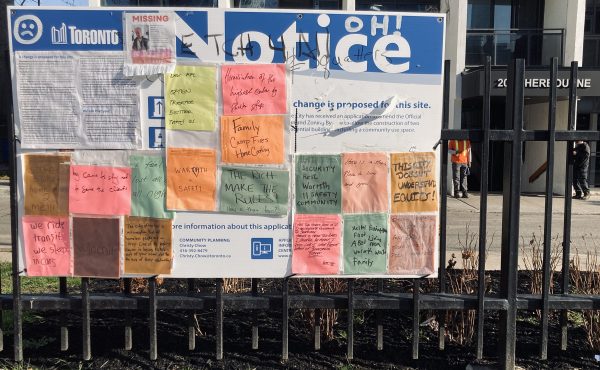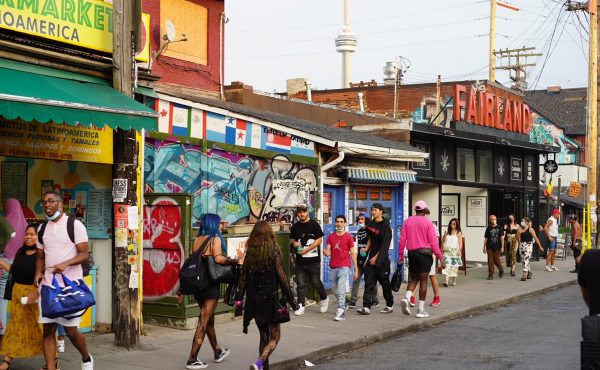Stroll through New York City’s Upper West Side and you will undoubtedly find yourself walking beneath a canvas entrance marquee. (Spacing senior editor Shawn Micallef wrote about this back in 2008). Perhaps you’ve huddled under one to take shelter from the rain. Or maybe you’ve had to dodge the metal supporting posts while navigating crowded sidewalks, thick with pedestrian traffic.
Canvas marquees first appeared on New York City sidewalks in the late 19th century, historically intended to provide well-to-do apartment dwellers and hotel guests with protection from the elements while accessing carriages and cars. Extending from the building entrance to the sidewalk edge, these canopies allow covered access from doorway to roadway and define space surrounding the building entrance. Today, although most often connected to large, upscale residential buildings and swank hotels, canvas entrance marquees can also be found on restaurants, nightclubs, and even take-out joints throughout the city.
Canvas entrance marquees are, as an urban artifact, “very New York”. You’ve seen them on television and in movies and while visiting the city. But in Toronto, such marquees are noticeably absent.
The Toronto Municipal Code pertaining to streets and sidewalks (Chapter 313) does permit the installation and maintenance of various building entrance encroachments, subject to approval. The Code requires that any canopy, awning, or marquee not extend beyond 0.46 meters from the street curb to maintain space for car doors and mirrors and that the overhead clearance must reach a minimum of 3.1 meters. The type of support post used is also subject to tight restrictions; if the entrance marquee requires supporting posts to meet the sidewalk, additional factors such as pedestrian flow and snow removal must be considered. As a result, canvas entrance marquees are essentially non-existent in Toronto.
“Many years ago, these marquees were a lot more common in Toronto,” said Kyp Perikleous, Manager of Right of Way Management for the City of Toronto’s Transportation Services. “More recently, people prefer a fixed awning. The maintenance level is much lower.”
Perikleous noted that the absence of entrance marquees in Toronto is a curious issue, less about streetscape structure and more about creating a sense of place. “I’m interested to know whether or not [the presence of entrance marquees] impacts the aesthetics of the neighborhood,” Perikleous said.
What impact do canvas entrance marquees really have on our Toronto streetscapes? Do these canopies simply provide shelter from the elements and define an entryway, or is their extension over the pedestrian right-of-way an encroachment into public space? Share your thoughts.
Photo by Wall Gobetz and Toronto Archives






3 comments
I think right now we’ve got the ugly step-daughter solution. People use patio umbrella’s attached to their buildings. This doesn’t work well as even large open windows are low enough that the umbrellas become too low and are a sidewalk hazard. See the pub across from the AGO at McCaul and Dundas for an example of this.
Interesting to note the near perfect sidewalk condition in the New York photo versus the broken curbs and infrastructure in the Toronto photo – typical of today’s condition. Even with our rethought guidelines for our streetscape we still find many non pedestrian-friendly conditions of garbage bins, news boxes, etc. impeding the pedestrian route, let alone my favourite peeve – boulevard patios that leave little space on the sidewalk for passing pedestrians and which have umbrella canopies so low that even the vertically challenged have to duck.
Another thing NYC businesses are allowed to do, via permit I presume, is to build temporary winter doors outside their business so that the cold wind doesn’t blow-in on patrons This could easily be allowed in T.O. as well. Here’s an example… http://www.signexponyc.com/images/Vestibules/Corner_Cafe.jpg